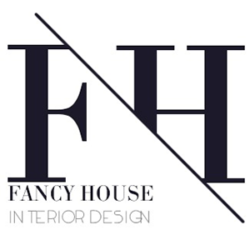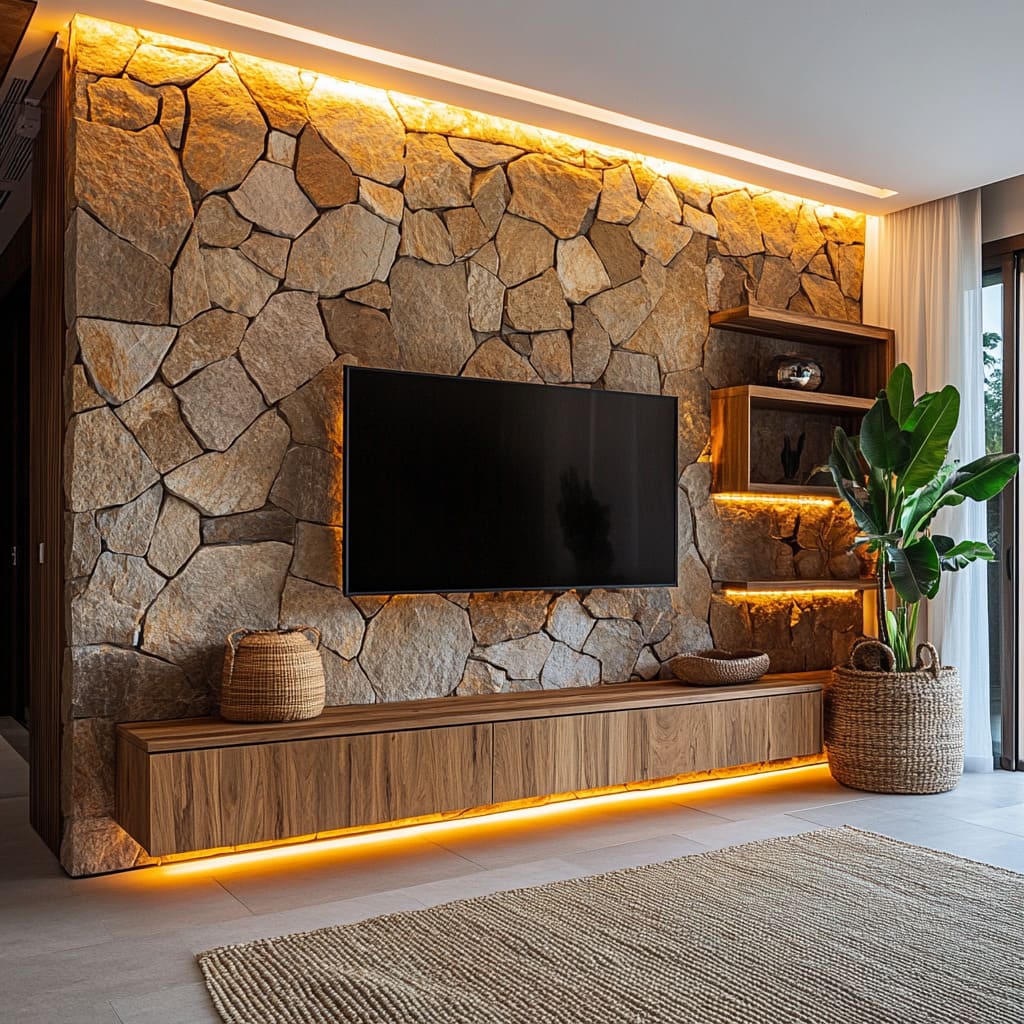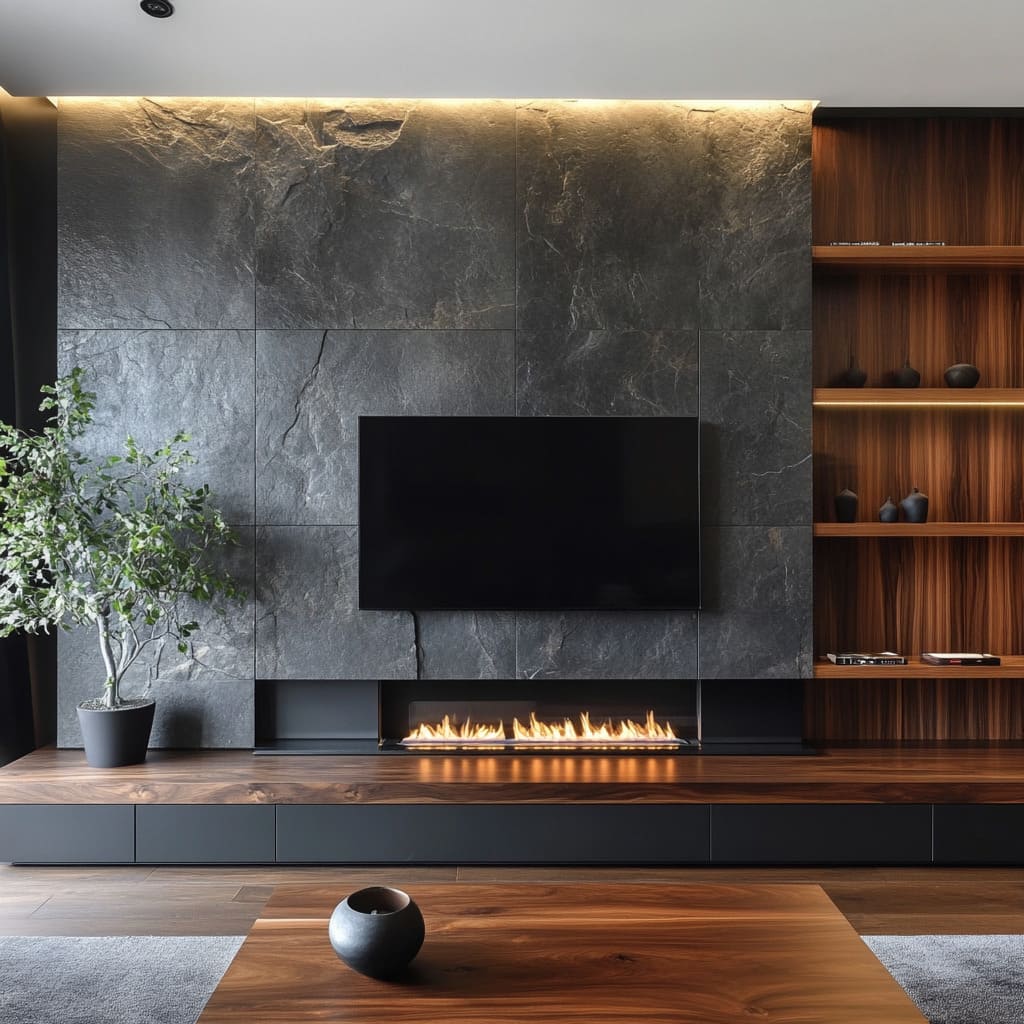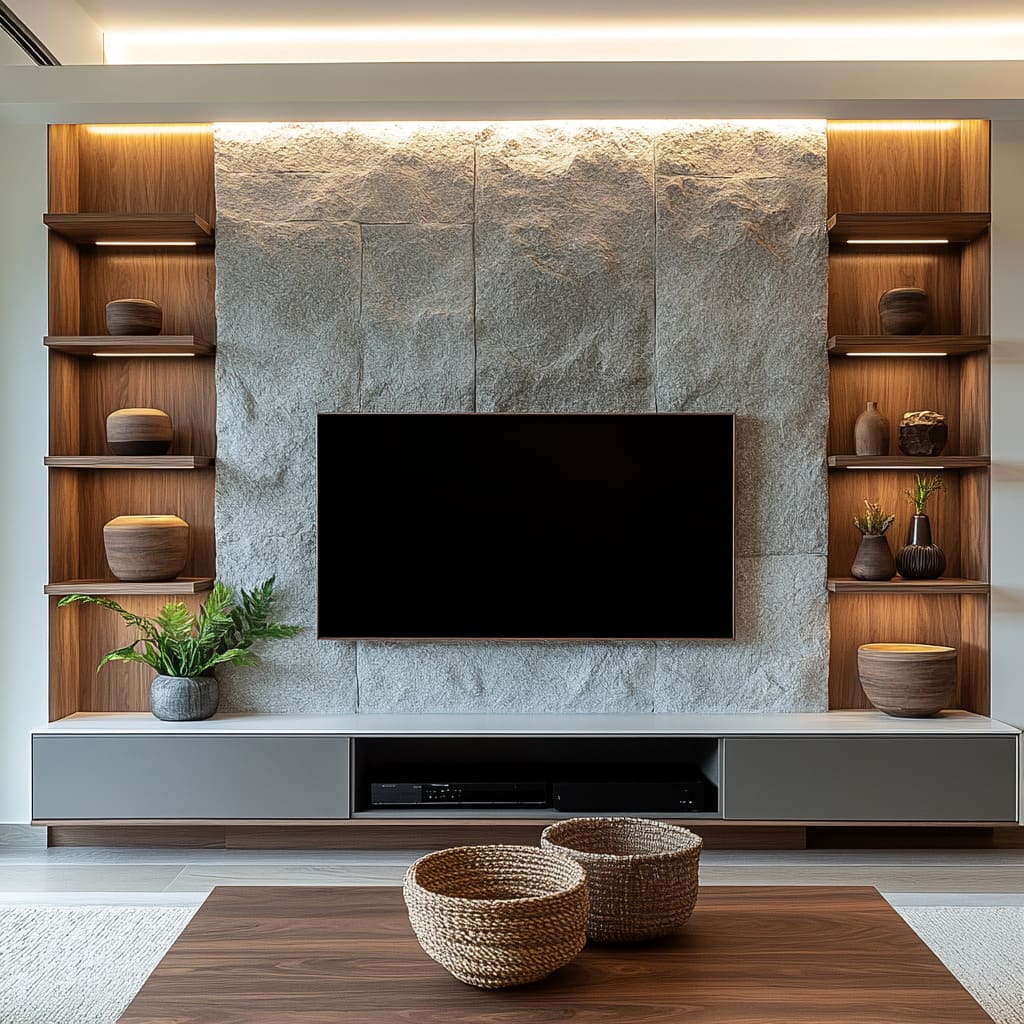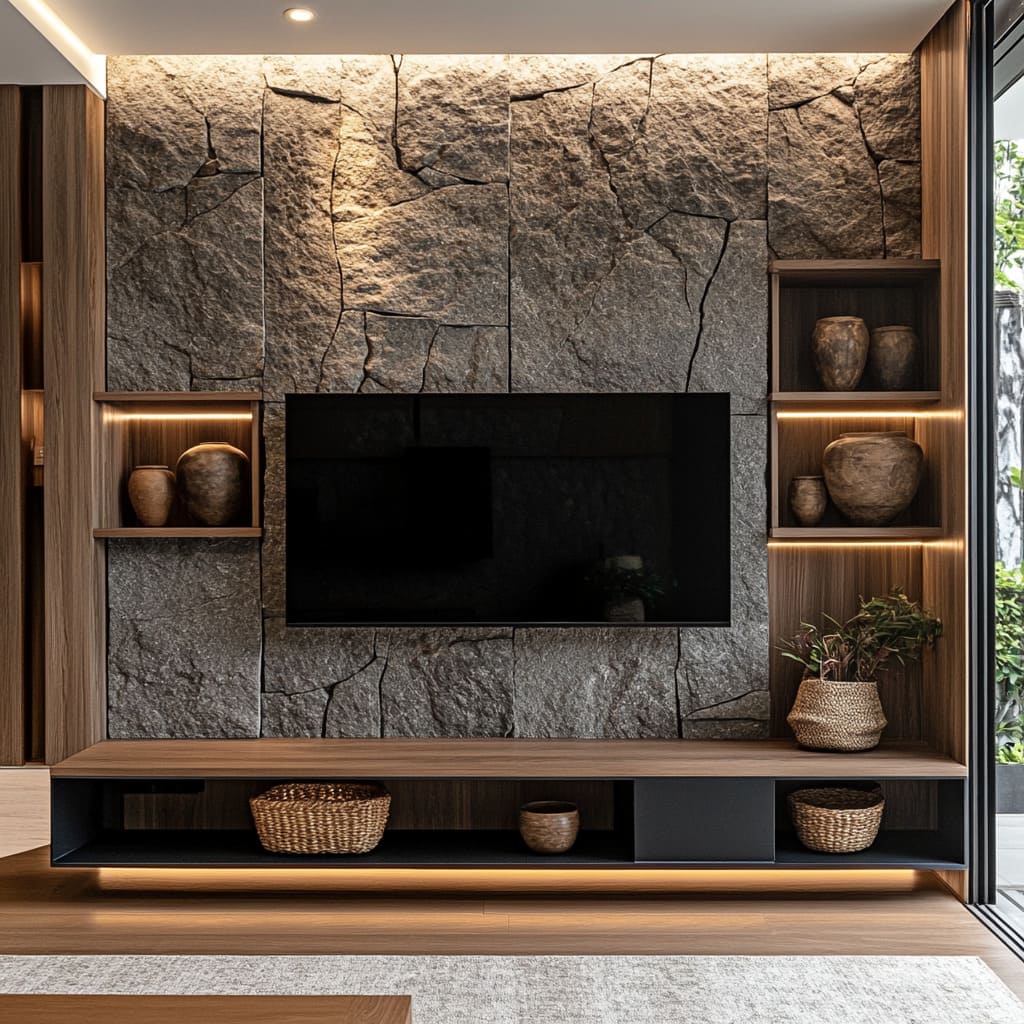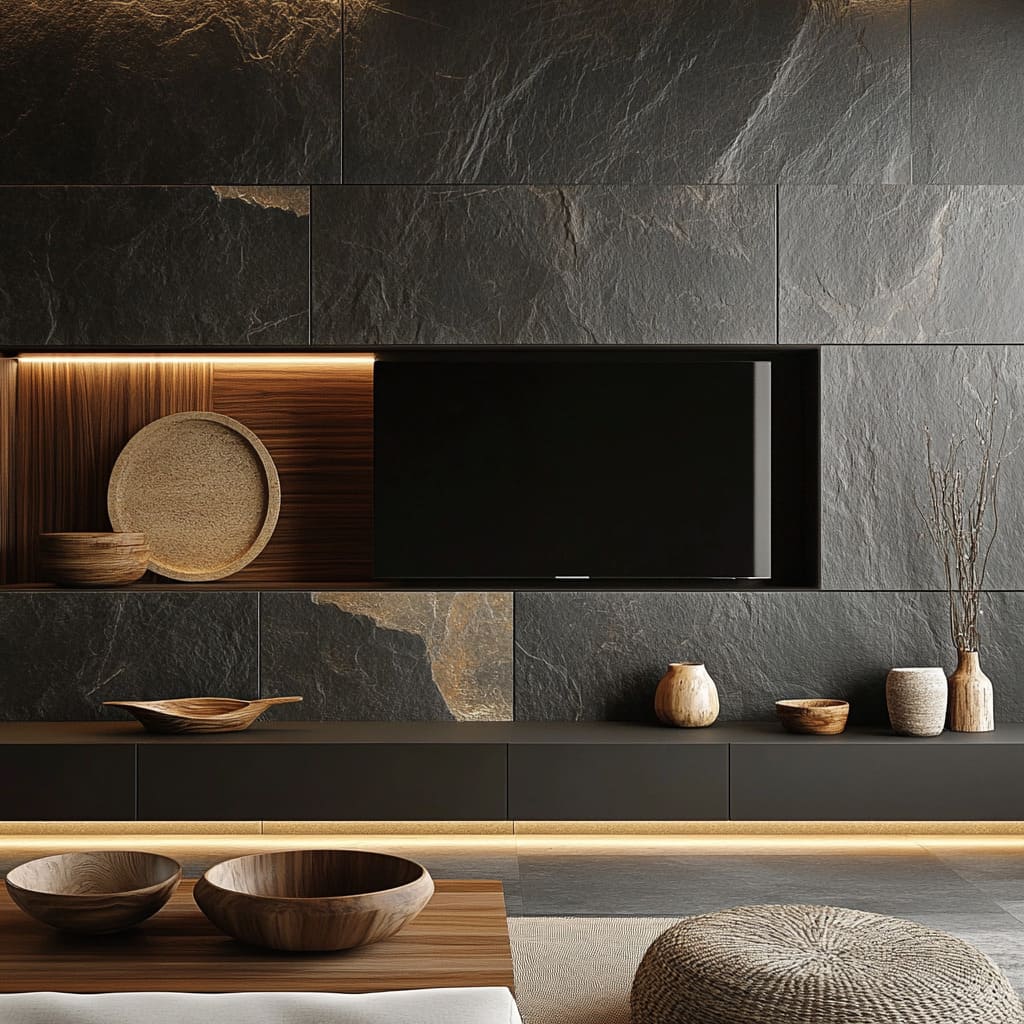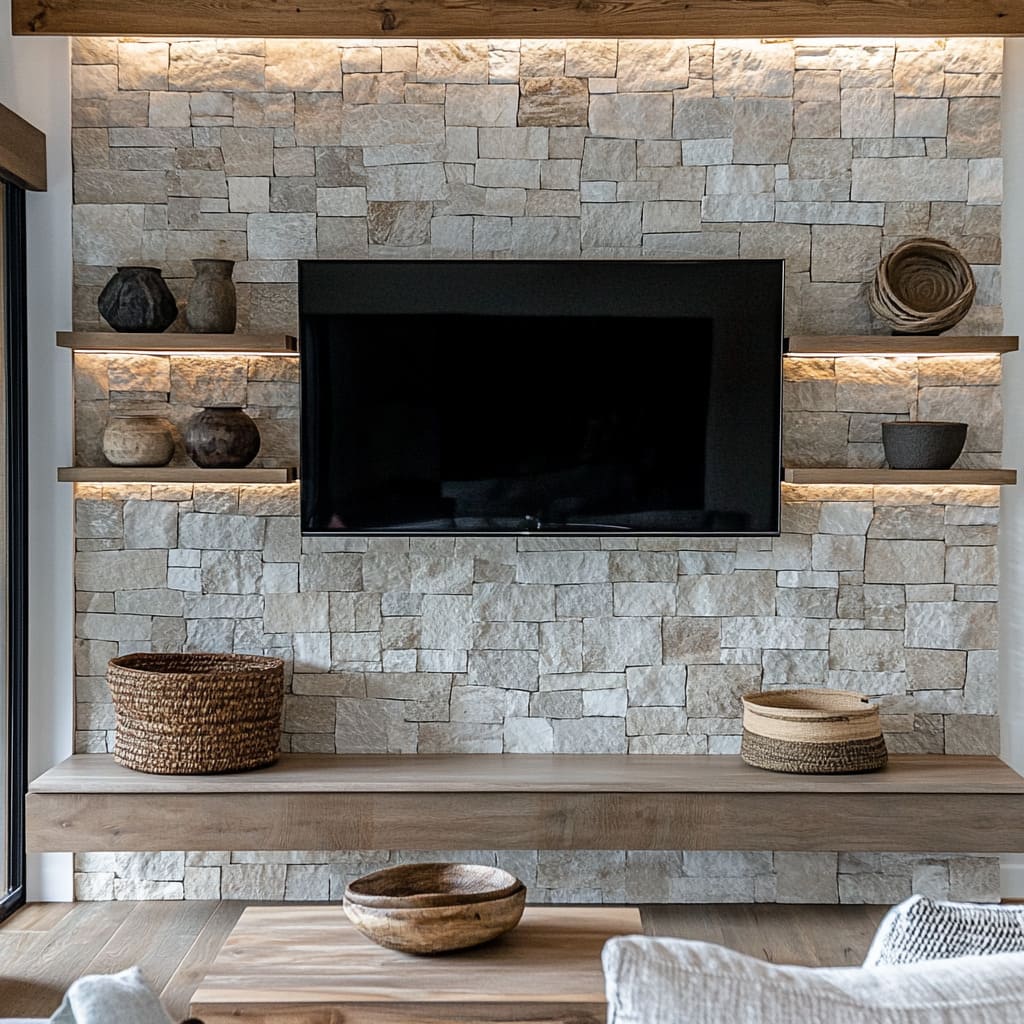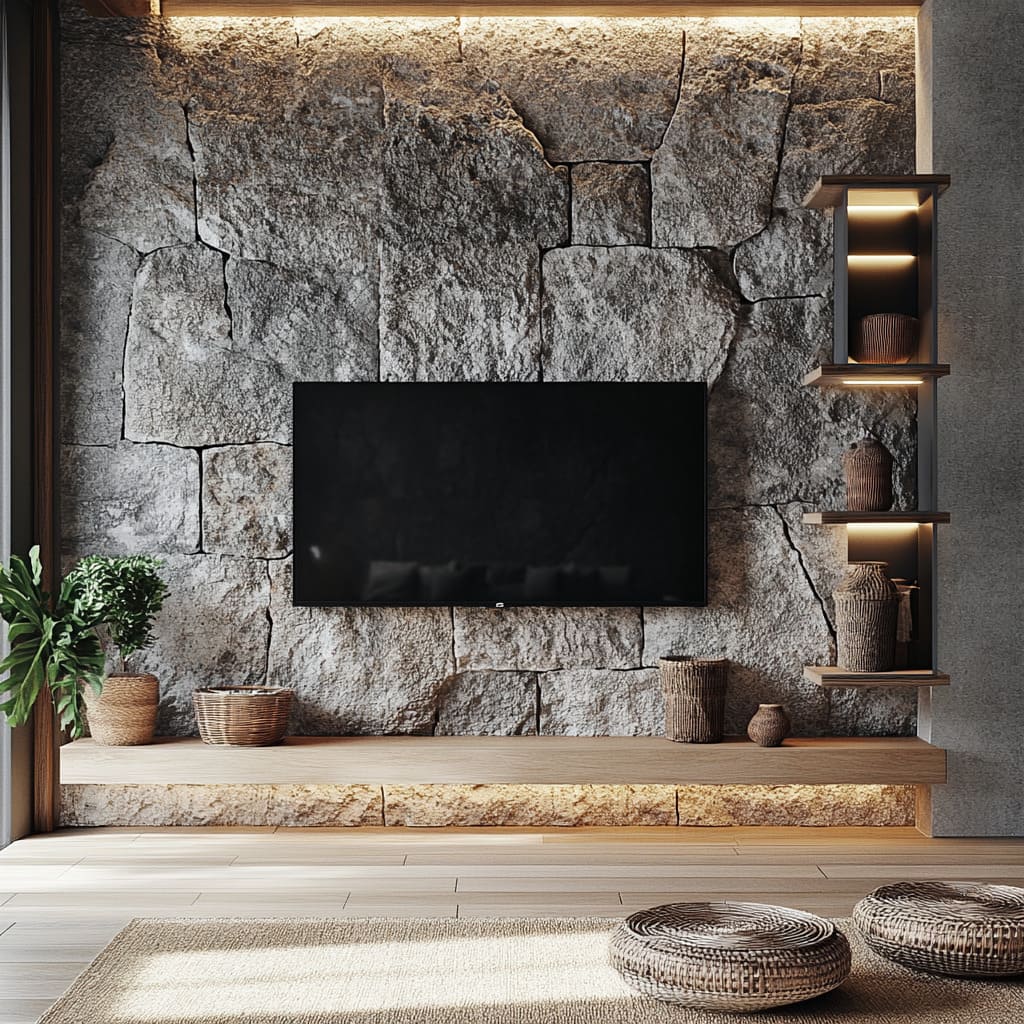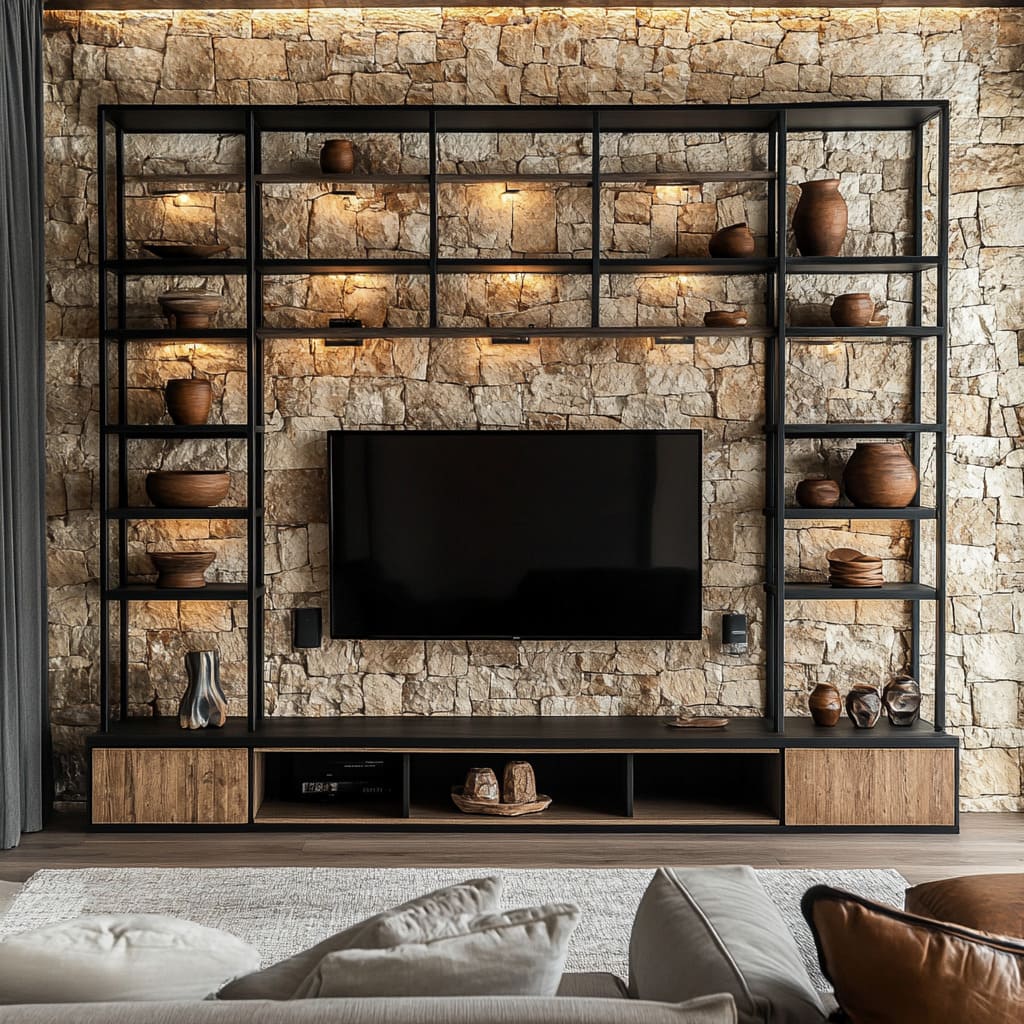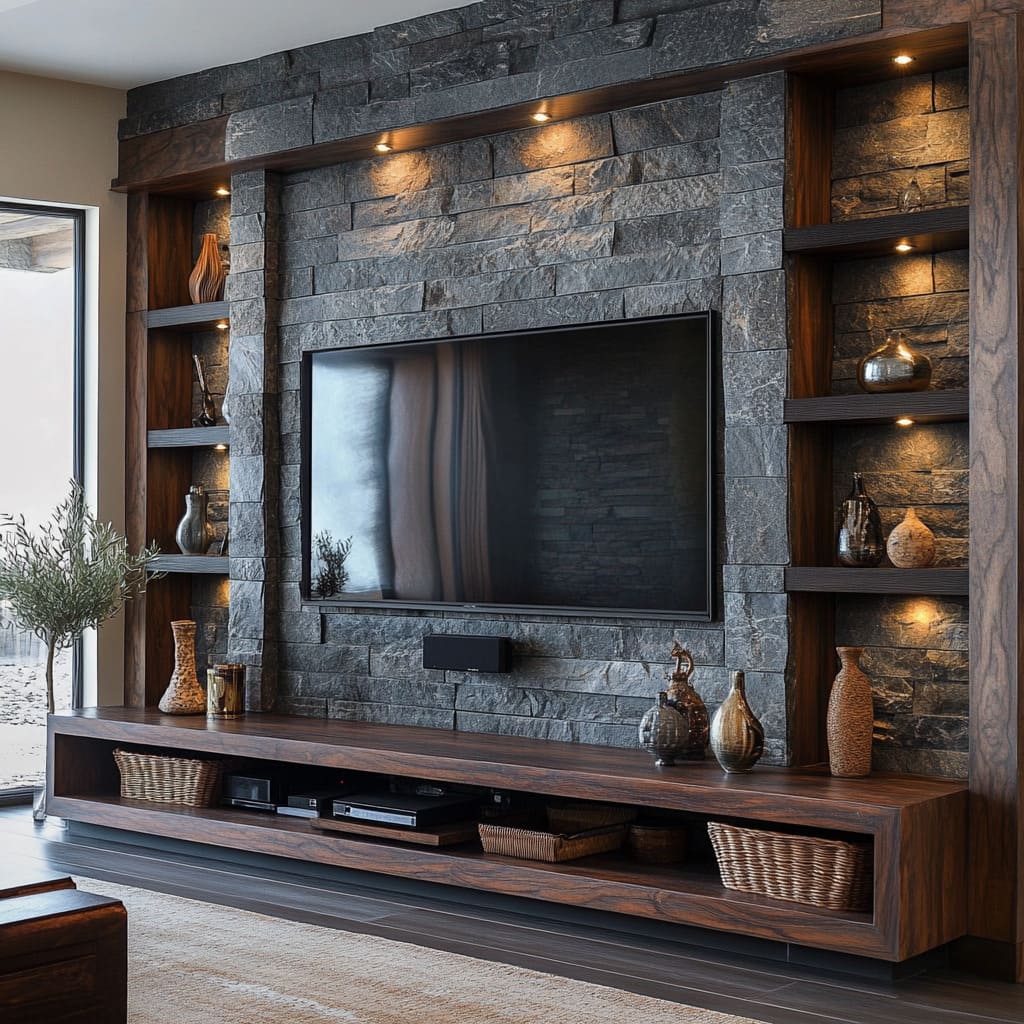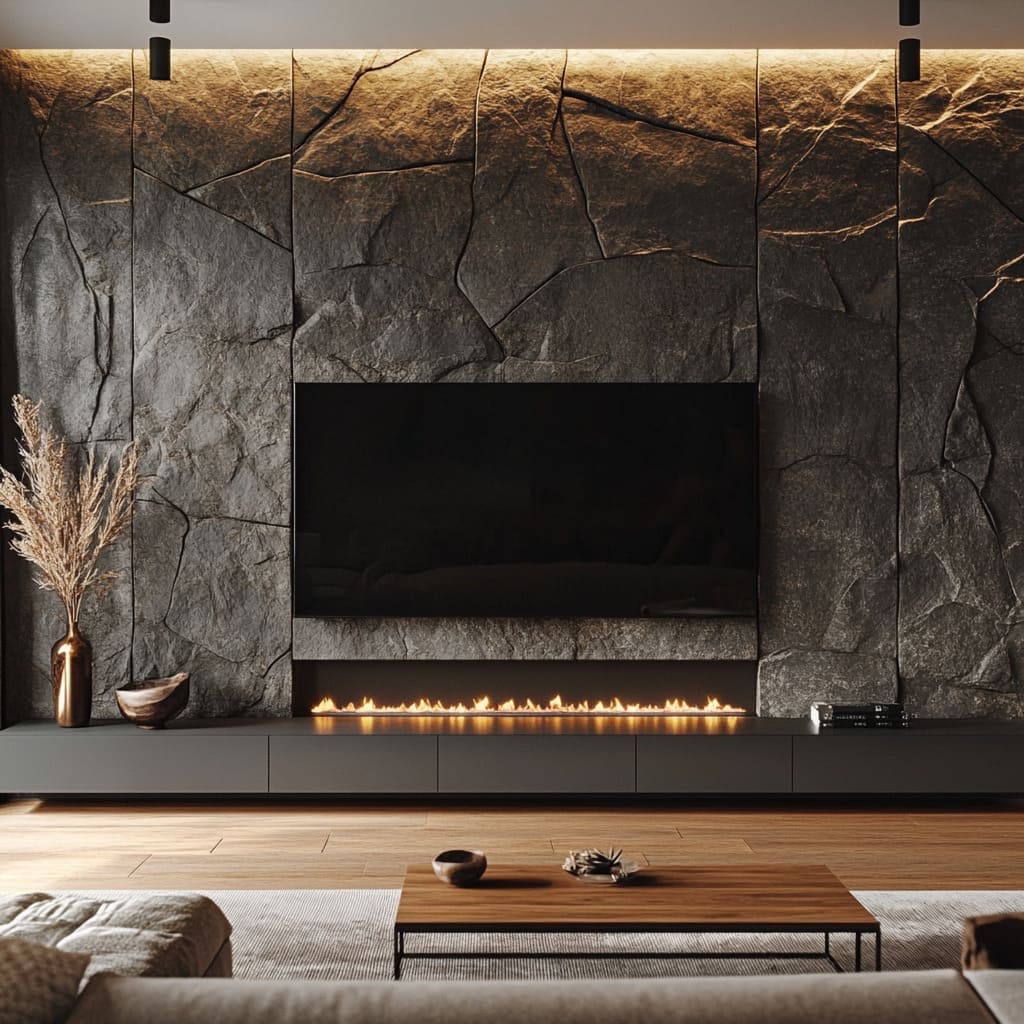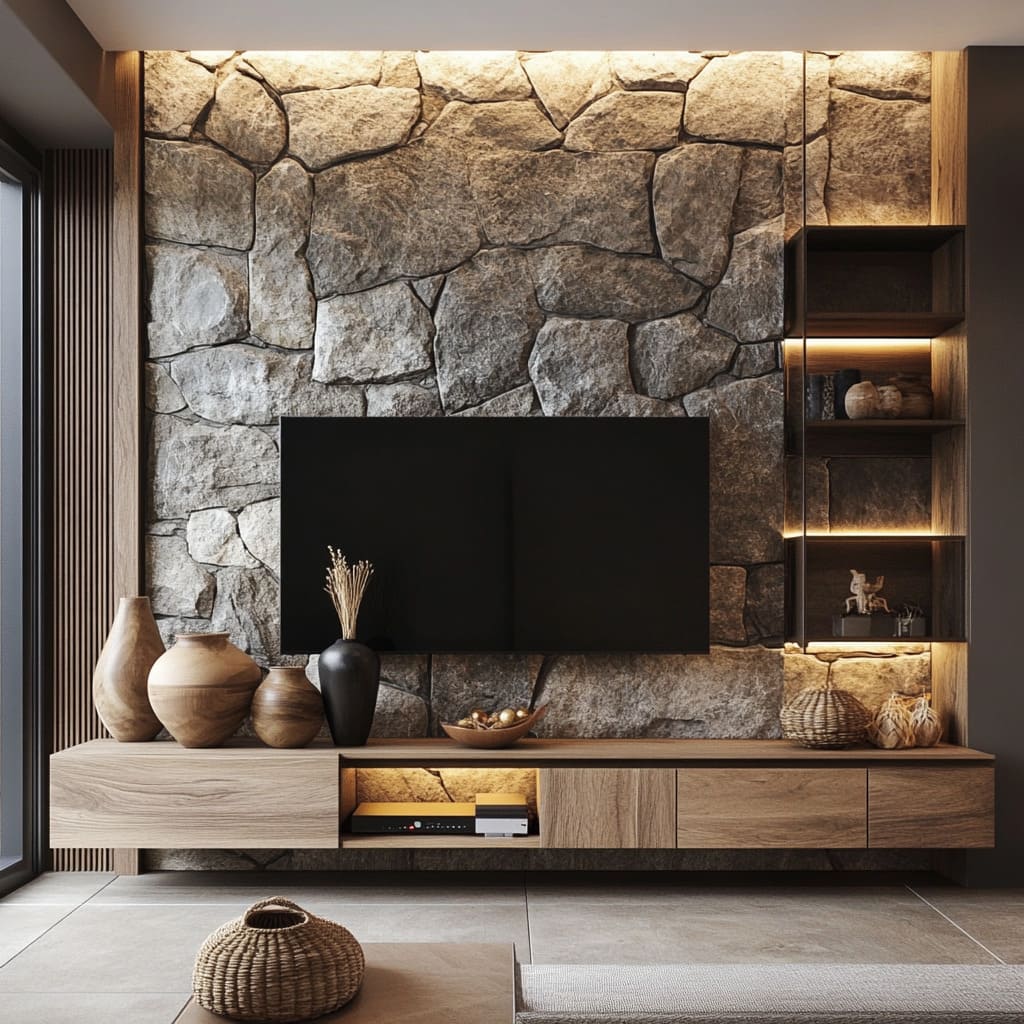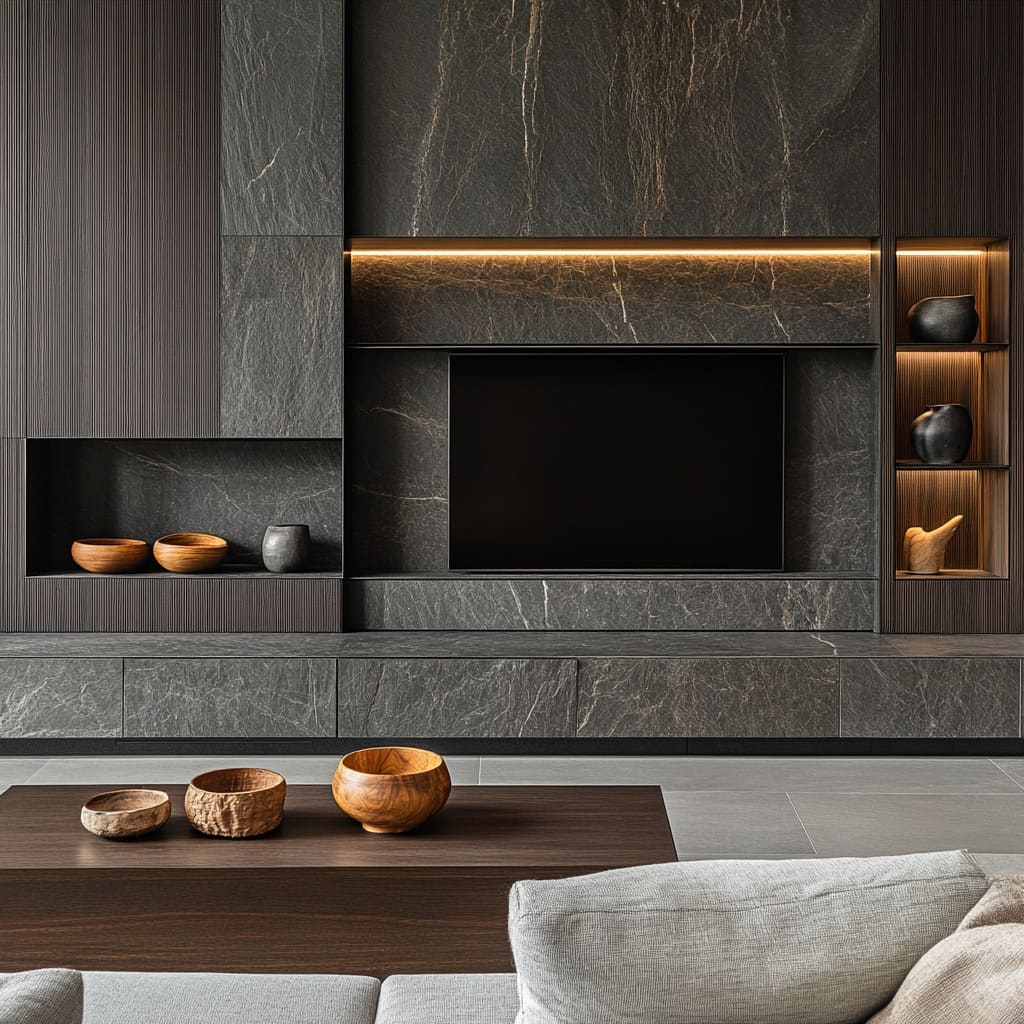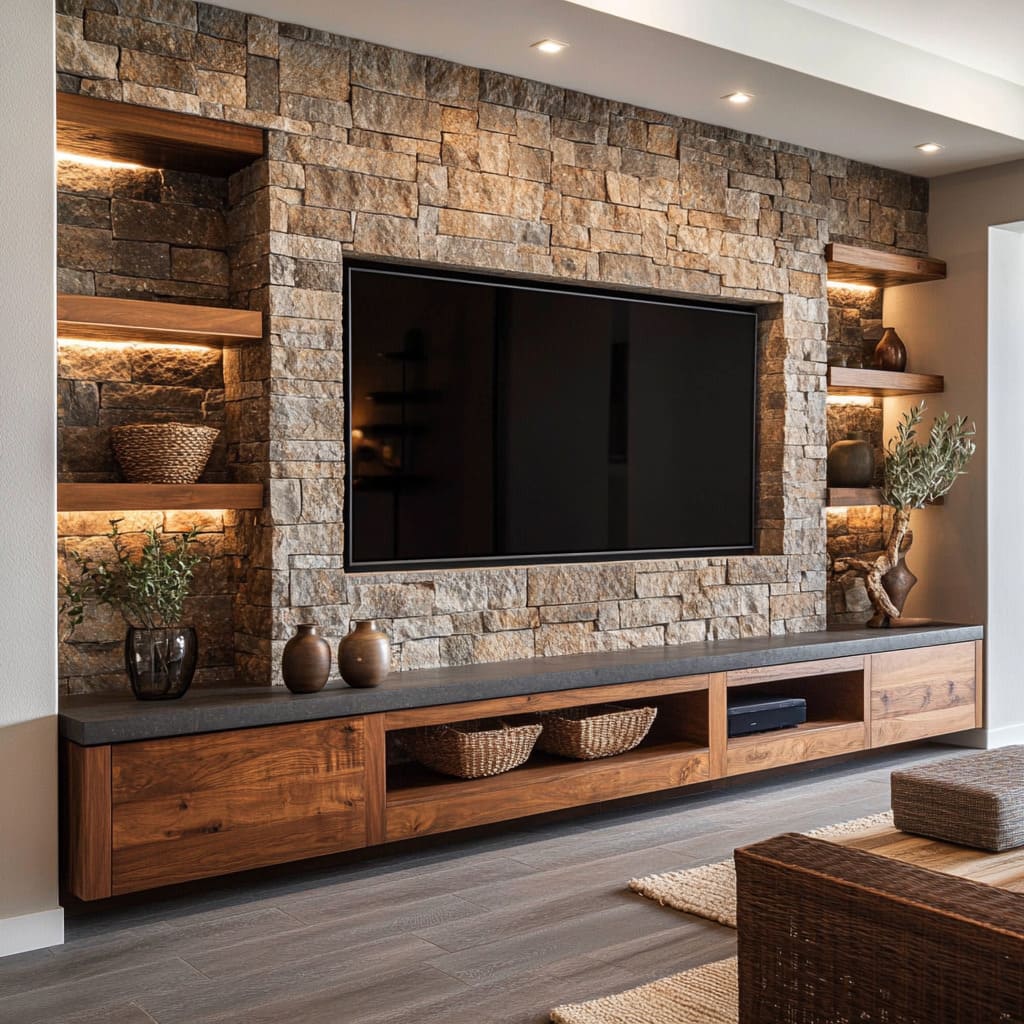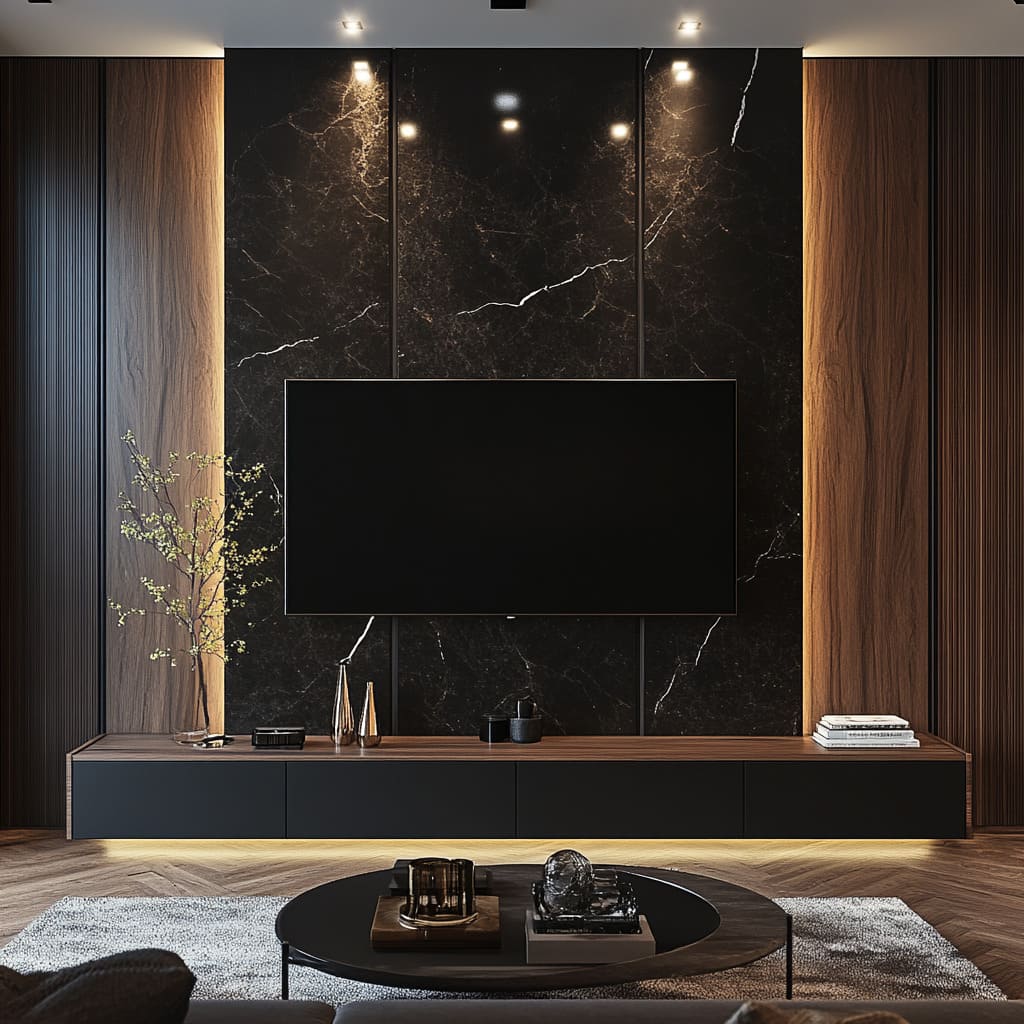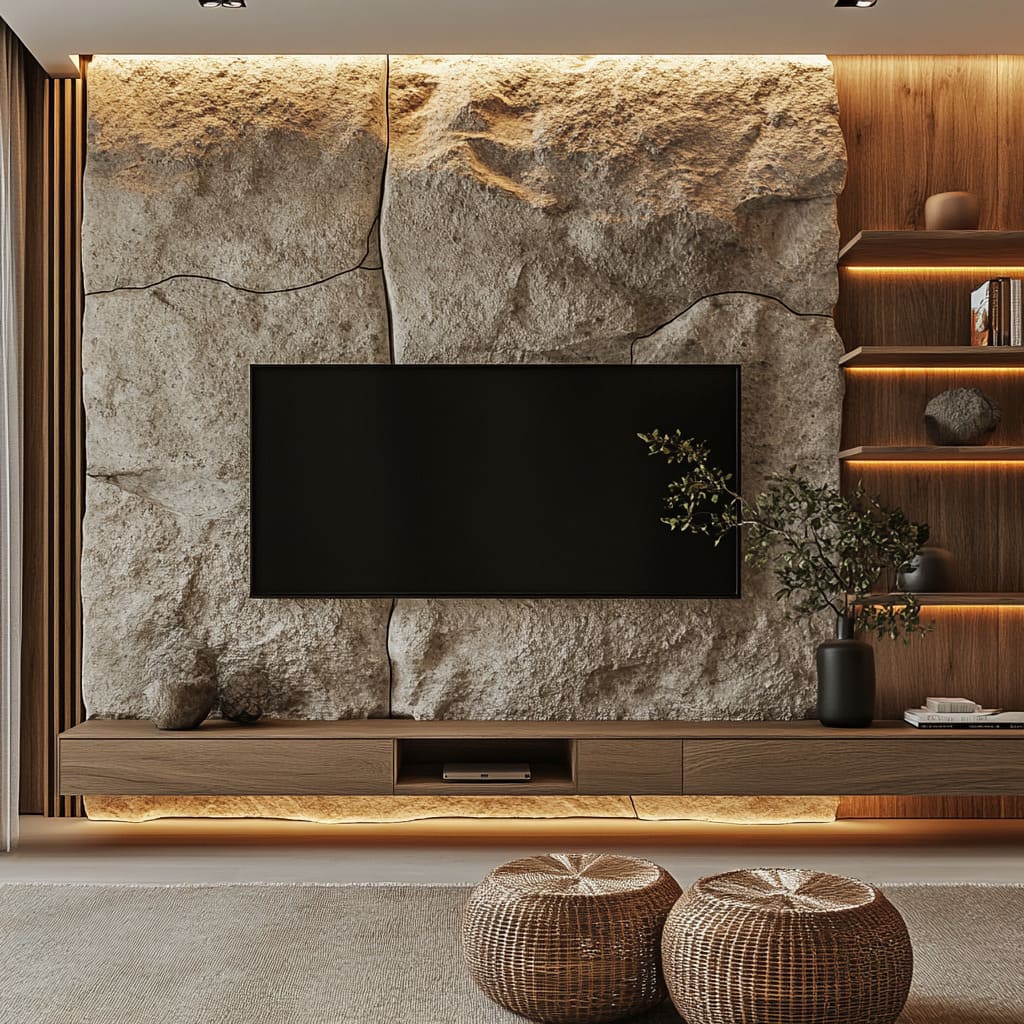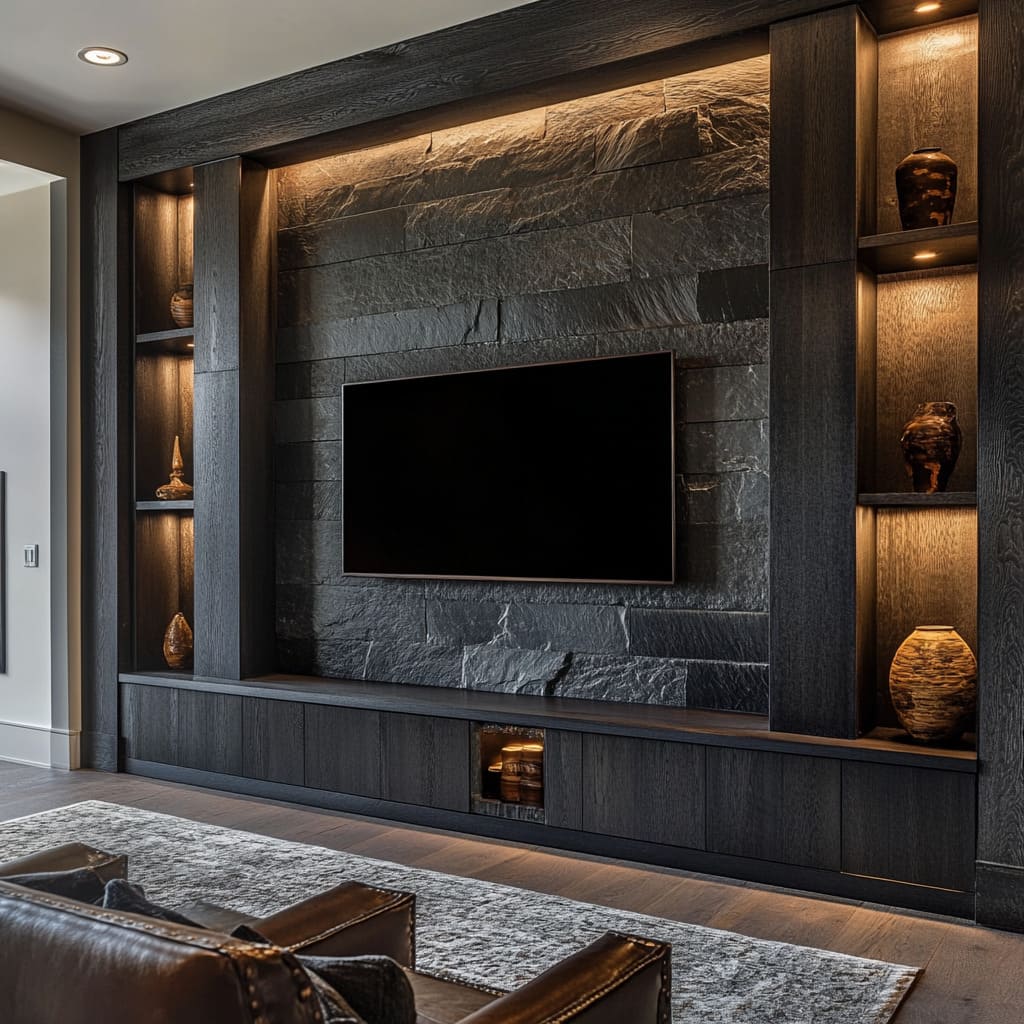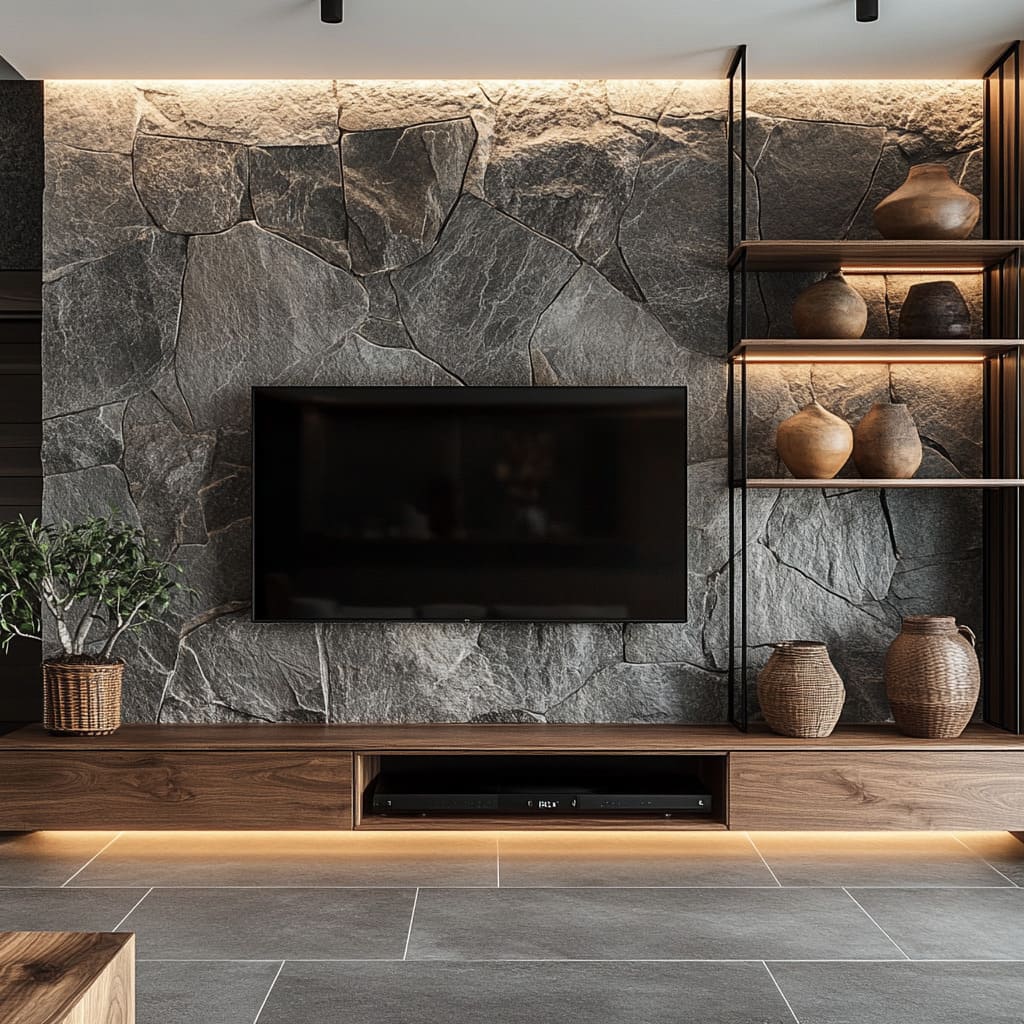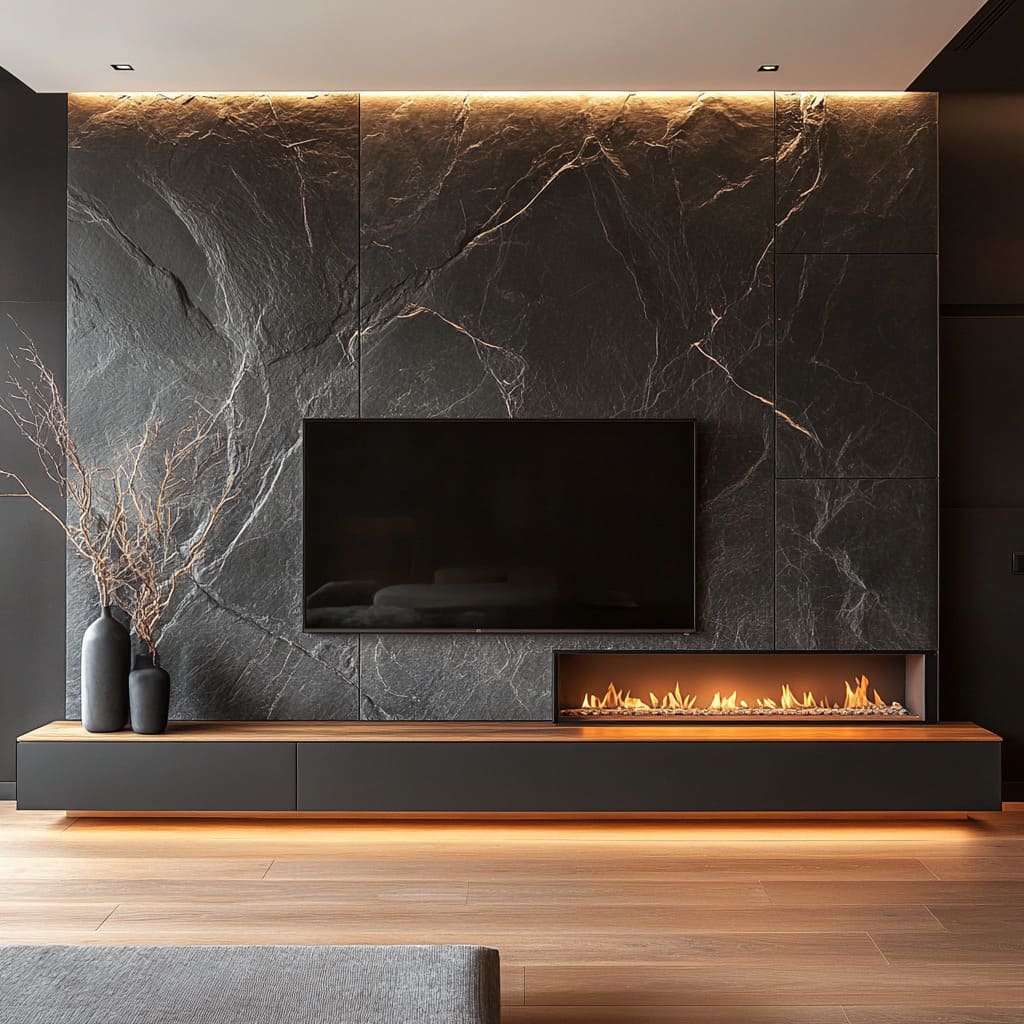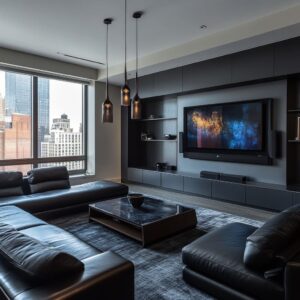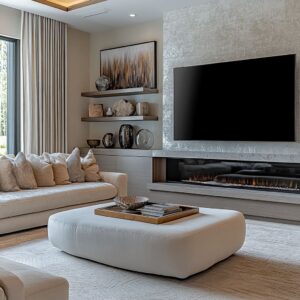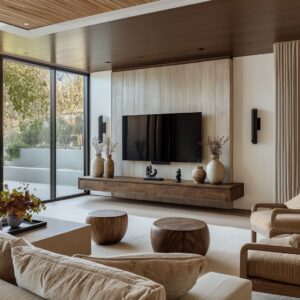A well-designed TV wall does more than hold a screen—it shapes the entire atmosphere of a space. Stone-clad TV walls have become a standout choice for those looking to add depth, texture, and a refined yet natural feel to their interiors.
Whether featuring large polished slabs for a sleek look or stacked stone for a more rustic feel, these walls introduce a level of sophistication that makes the TV area feel intentional rather than an afterthought. Beyond aesthetics, smart TV design ideas incorporate lighting, floating elements, and mixed materials like wood and metal to create a composition that feels balanced and functional.
Storage solutions, hidden technology, and thoughtful layering ensure that the design stays clean while still feeling warm and inviting. The right combination of materials and layout can make a stone-clad TV wall the defining feature of a living room, blending practicality with a strong visual presence.
From minimalist installations to bold statement pieces, the variety of approaches to stone TV walls offers something for every style. The key lies in understanding how each element—texture, lighting, and structure—works together to create a space that feels curated and complete.
The Connection Between Stone Texture and Lighting in a Unique TV Wall
Lighting plays a crucial role in shaping the way a unique TV wall feels and looks, especially when stone is involved. Designers don’t just illuminate these walls—they use light to emphasize texture, highlight details, and create depth that wouldn’t exist on a smooth surface.
It’s not just about brightness; it’s about how shadows and highlights interact with the natural qualities of the stone.
Shadows That Shape the Space
One of the most striking effects of textured stone is the way light interacts with uneven surfaces. When stones protrude, they cast small shadows that break up the wall visually, making it feel more dynamic and layered.
This is particularly effective in rooms where designers want to introduce a sense of movement without overwhelming the space with excessive decoration. A well-placed light source can make rough surfaces stand out more, turning what might have been a simple accent wall into a striking design feature.
Targeted Lighting vs. General Illumination
While overhead lighting might brighten an entire room, it does little to showcase the depth and texture of a stone wall. This is why designers often rely on concealed LED strips positioned along edges, inside shelving, or behind architectural features.
These focused light sources bring out the natural cracks, veins, and rugged qualities of the stone, making every detail stand out. This technique is particularly dramatic on darker stone walls, where even the slightest angle can create a striking contrast between illuminated areas and deep shadows.
The Role of Color Temperature in Setting the Mood
Beyond brightness and positioning, the color of the light itself plays a huge role in how the stone is perceived. A neutral stone might take on a much warmer, inviting tone when lit with soft golden lighting in the 2700K–3000K range.
In contrast, a cooler 4000K–5000K light source enhances the raw, modern qualities of the stone, making the space feel sharper and more contemporary. This subtle shift can completely change the atmosphere of a room, proving that lighting isn’t just functional—it’s a fundamental part of the design itself.
By combining the right lighting angles, intensities, and temperatures, designers turn a stone-clad wall into more than just a background for a television. It becomes an element that interacts with the space, constantly shifting in depth and texture as light moves across its surface.
Layering Effects and Illusions of Floating Elements in TV Wall Design
A well-planned TV wall design isn’t just about aesthetics—it’s about creating a sense of balance between weight and lightness. Designers achieve this by incorporating floating consoles, open shelving, and recessed TV panels that seem to hover in place.
This effect isn’t only for show; it helps shape the way a room feels, making a substantial stone feature wall appear more refined and intentional.
A Visual Lift for Heavy Materials
Stone naturally carries a sense of weight, and without careful design, a full-height stone wall can feel overwhelming. Floating elements, such as wall-mounted media consoles or shelves, break up this mass, allowing negative space to introduce contrast.
This gap between the floor and furniture prevents the design from feeling too grounded, instead giving it a sense of lightness. By lifting key features off the floor, designers create a structured composition where the stone remains the dominant backdrop, but without making the space feel visually dense.
Layering for Depth and Dimension
Some of the most striking designs take advantage of projections—sections of stone or wood panels that extend slightly forward, creating a structured, multi-dimensional effect. This approach introduces variation within the surface, avoiding the monotony of a completely flat stone expanse.
Whether through staggered stone slabs or deep wooden ledges, layering brings movement and architectural depth, making the wall feel more like a sculptural feature rather than just a surface for mounting a TV.
The Role of Lighting in Floating Designs
One of the most overlooked techniques is the use of under-lighting beneath floating elements. A subtle LED strip tucked under a floating console or shelf enhances the weightless effect, detaching it from the wall and creating a soft glow that accentuates depth.
This lighting trick is particularly effective with darker stone surfaces, where even a small amount of illumination can make floating elements stand out. By integrating floating components into a TV wall design, the overall look remains balanced—grounded in strong, natural materials while maintaining an airy, sophisticated presence.
Mixed Material Strategy: Wood, Metal, and Stone in TV Wall Design
A TV wall design that blends multiple materials isn’t just about style—it’s about contrast, balance, and bringing together elements that enhance each other. Stone sets the foundation, but the right combination of wood, metal, and even glass can transform the entire feel of the space.
Designers use these materials not only to soften or highlight stone but to introduce structure, warmth, and refined details that take the design beyond a simple feature wall.
Balancing Warm and Cool Tones
Stone, especially in gray or darker shades, has a naturally cool undertone. While this adds a modern and grounded aesthetic, too much of it can make a space feel cold or uninviting.
This is where wood comes in. By integrating warm-toned wooden panels, floating shelves, or a full-length media console, the overall design gains contrast that makes the stone look more intentional rather than overwhelming.
Some of the most striking combinations place wood directly against stone, creating an instant textural and color balance that keeps the wall from feeling too stark.
Metal as a Defining Element
Thin metal frames or accents bring structure to the organic nature of stone. Whether framing a set of open shelves, bordering a recessed TV niche, or outlining a wooden console, metal adds crisp definition.
This technique is especially effective in designs that feature rough, uneven stone textures—where a sleek black or brushed brass frame introduces a striking contrast that emphasizes the stone rather than competing with it.
Matte Finishes for a Sophisticated Look
One of the most overlooked details in mixed-material walls is the choice of finish. High-gloss wood or polished metal can reflect too much light, which might take attention away from the stone’s natural patterns and texture.
That’s why many designers opt for matte finishes in wood and metal elements. A soft, low-sheen wood panel allows the stone to be the highlight, while a blackened steel frame around a shelving unit provides structure without drawing too much focus.
By layering materials thoughtfully, a TV wall design can shift from being a simple backdrop to a focal point with character and depth. The combination of warm wood, strong stone, and structured metal creates a design that feels balanced, cohesive, and rich in visual interest.
Fireplace Integration as a Focal Counterpoint in a Designer TV Wall
Pairing a fireplace with a designer TV wall isn’t just about aesthetics—it’s a carefully planned interaction between warmth, movement, and structure. The contrast between flickering flames and solid stone creates a layered visual experience, giving the wall an active presence even when the TV is off.
This combination enhances both elements, turning them into complementary focal points rather than competing features.
Light and Dark: A Balancing Act
A fireplace introduces natural movement and warmth, something that contrasts beautifully with the cool, static nature of stone. In darker designs, flames break up the solidity of the backdrop, creating a dynamic interplay that shifts with the lighting in the room.
The balance between these elements allows attention to flow naturally between the TV and the fireplace, keeping the wall from feeling overly heavy or monotonous.
Horizontal and Vertical Composition
The placement of a fireplace beneath a TV isn’t random—it’s a structural decision that stabilizes the overall design. The elongated horizontal form of a linear fireplace acts as a counterweight to taller vertical elements, such as stone slabs or wood panels that extend to the ceiling.
This structured layering prevents the design from feeling top-heavy and gives the wall a well-proportioned, architectural presence.
Reflective Surfaces and Firelight Interaction
Certain stone finishes, particularly polished marble or subtly veined slabs, take on a new dimension when paired with a fireplace. The glow from the flames can catch natural patterns in the stone, making the surface appear to shift and flicker alongside the fire.
This effect is particularly striking in darker materials, where warm reflections add depth, making the stone feel almost alive with movement.
The Fire’s Influence on Color and Mood
One of the most understated details in fireplace and TV wall pairings is how the flame’s hue interacts with the surrounding materials. A golden fire enhances the warmth of beige, tan, or brown-toned stone, making it feel richer and more inviting.
In contrast, against deep charcoal or black stone, the fire’s glow adds just enough contrast to prevent the design from feeling too stark. This thoughtful balance between fire and stone transforms a static feature wall into an evolving focal point that adapts to the light and atmosphere of the room.
By integrating a fireplace with a designer TV wall, the space gains not just warmth but a refined layering of elements that enhance each other, creating a statement piece that stands out even when the screen is turned off.
Subtle Approaches to Concealing Technology in a Creative TV Unit
A creative TV unit isn’t just about aesthetics—it’s about seamless functionality. The best designs hide technology without sacrificing style, ensuring that cables, devices, and mounting hardware don’t interfere with the clean look of a stone-clad wall.
Achieving this level of refinement requires smart planning, built-in solutions, and a careful selection of finishes that make technology feel like an intentional part of the design rather than an afterthought.
Hidden Cable Management for a Clutter-Free Look
A beautifully designed TV wall loses its impact if a tangle of wires is visible. High-end setups incorporate recessed channels behind the stone or within the floating console, allowing all cables to remain completely hidden.
This approach does more than eliminate distractions—it maintains the uninterrupted flow of the materials, keeping the focus on the textures and layering rather than the technical elements behind the screen.
Recessed Niches for Media Devices
One of the most practical yet often overlooked details in modern TV wall design is the integration of small, built-in niches to house media players, gaming consoles, or streaming devices. These compartments, often backlit for a subtle glow, ensure that devices have proper ventilation while keeping them out of sight.
By embedding them into the console or directly into the stone wall, designers create a functional storage solution that blends effortlessly with the surrounding materials.
Matte Screens for a Seamless Appearance
The choice of screen finish plays a subtle but significant role in the overall design. Many high-end TV walls feature ultra-black matte screens that minimize glare and reflections.
When turned off, these screens blend into darker stone surfaces, making the TV appear almost like an extension of the wall itself. In setups where contrast is preferred, a matte-finish screen against a lighter stone background creates a refined focal point without drawing attention away from the surrounding textures.
By carefully integrating these elements, a creative TV unit achieves a balance between design and technology, ensuring that every detail contributes to a sleek, streamlined look without compromising functionality.
Composition Through Vertical and Horizontal “Breaks” in TV Unit Design
A well-structured TV unit design relies on a careful balance of vertical and horizontal elements. Without this interplay, a stone-clad wall can feel too rigid or overwhelming.
Designers use contrasting lines to create movement, add depth, and establish a sense of proportion that enhances both the TV and the surrounding features.
Vertical Slats and Ribbed Wood for Height
One of the most effective ways to break up a stone wall is by introducing vertical wood paneling or ribbed detailing. This technique draws the eye upward, emphasizing height and making the space feel more expansive.
Whether running from floor to ceiling or strategically placed alongside the TV, vertical elements create structure while introducing warmth and texture that complement the raw beauty of the stone.
Horizontal Ledges and Floating Consoles for Stability
To counterbalance tall vertical features, long horizontal elements—such as floating shelves or extended media consoles—help ground the composition. A well-placed ledge beneath the TV creates a visual foundation, anchoring the screen within the larger design.
This horizontal emphasis also works well when the stone itself has strong vertical seams, ensuring the space doesn’t feel too linear or repetitive.
Aligning Elements for a Cohesive Layout
The most sophisticated designs take alignment seriously, ensuring that vertical ribs or shelving lines up precisely with major seams in the stone. This level of coordination makes the composition feel intentional rather than random.
Whether using thin wooden slats, metal accents, or recessed shelves, designers carefully place these elements to create a structured, geometric balance that enhances the entire wall. By thoughtfully integrating vertical and horizontal breaks, a TV unit design becomes more than just a space for a screen—it transforms into an architectural feature that feels layered, well-proportioned, and visually engaging.
Color Palettes and Stone Variations in TV Unit Design
The color and texture of stone play a key role in shaping the overall mood of a TV unit design. While gray and black stone are commonly used for a sleek, modern aesthetic, the full spectrum of stone hues offers a wide range of possibilities.
Designers carefully select tones not only for their standalone appeal but for how they interact with lighting, surrounding materials, and the overall room composition.
Warmer Tones for a Softer Look
Lighter stone shades—such as beige, cream, and golden-brown—help to soften a modern space, keeping it from feeling too stark or industrial. These colors work particularly well when paired with wood, enhancing warmth and creating a more inviting atmosphere.
In open spaces where natural light plays a big role, these hues help reflect brightness, making the wall feel airy rather than heavy.
Dark Stone for Depth and Contrast
For a bold, sophisticated presence, deeper shades like charcoal, slate gray, and black bring a sense of depth that instantly modernizes the space. When combined with rich wood tones, dark stone creates a striking contrast that feels intentional and refined.
In some cases, subtle white or gray veining within the stone becomes a natural design feature, drawing the eye and adding movement to an otherwise solid surface.
Thoughtful Color Variation for Balance
A well-executed stone wall isn’t just about a single color—it’s about balance. Some designs use carefully curated mixes of grays, browns, and tans, ensuring that the variation looks organic rather than random.
The goal is to create a cohesive appearance that enhances the natural qualities of the stone while avoiding a mismatched or patchwork effect.
The Impact of Lighting on Color
One of the most overlooked aspects of stone selection is how it responds to different lighting conditions. A wall that appears warm and neutral in daylight might take on a cooler, more dramatic tone under artificial lighting.
This is why designers often test stone samples under various light sources, ensuring that the chosen material remains visually appealing from morning to evening. By thoughtfully selecting and arranging stone hues, a TV unit design becomes more than just a background—it turns into a carefully crafted composition that enhances both the television and the surrounding decor.
Shape of the Stone Pieces: Panels vs. Irregular Chunks in the Best TV Unit Design
The choice of stone shape has a major influence on the overall look and feel of a best TV unit design. Whether designers opt for sleek monolithic slabs or textured stacked stones, the selection plays a role in how the space is perceived.
Some walls aim for precision and refinement, while others embrace natural irregularities for a more organic appearance.
Large Slabs for a Seamless, High-End Look
Monolithic stone panels create a bold statement, offering an uninterrupted surface that feels polished and modern. In some designs, the natural veining of marble or quartzite is carefully aligned across multiple slabs, a technique known as book-matching.
This approach enhances symmetry, making the patterns appear as if they naturally flow from one section to the next. Large-format slabs are often seen in high-end interiors, where a clean, continuous surface reinforces a sense of sophistication and intentional design.
Stacked Stones and Chiseled Blocks for Texture
In contrast, smaller stone pieces—whether stacked, layered, or roughly chiseled—add depth and texture to a space. This method highlights the raw beauty of stone by showcasing variations in shape, tone, and surface irregularities.
The presence of visible gaps and mortar lines gives the wall a handcrafted quality, making it feel more tactile and inviting. This approach works particularly well in settings where a rustic or natural aesthetic is desired, bringing warmth and an element of history into the design.
How Stone Size Affects Perception of Space
Beyond aesthetics, the scale of the stone impacts how the room feels. Large slabs create a sense of continuity, making a wall feel expansive and sleek.
On the other hand, smaller, stacked stones introduce intricate details that draw the eye, making the space feel layered and textural. Interestingly, using many small pieces can make a wall appear larger, as the individual elements create a sense of repetition and movement.
By carefully selecting the right stone format, designers shape the visual experience of the wall, ensuring that every element—whether smooth and refined or rough and organic—works in harmony with the best TV unit design for the space.
Functionality Hiding Within Artful Display
A well-designed TV wall doesn’t just serve as a place to mount a screen—it blends storage and display in a way that feels effortless. Shelves and floating consoles are more than decorative add-ons; they create balance, offering both practical storage solutions and carefully arranged elements that enhance the space.
The Balance Between Display and Storage
A great shelving setup isn’t just about showing off décor—it also needs to be functional. Open shelves might showcase sculptural vases, pottery, or woven baskets, but they can just as easily store books, media devices, or even small personal items.
The trick is to mix both approaches, allowing some compartments to be purely decorative while others remain practical. Closed storage compartments play a crucial role in keeping the overall look streamlined.
By tucking away clutter—cables, remote controls, and everyday essentials—the design stays clean and intentional. This combination ensures that the space feels curated rather than chaotic.
The Illusion of Minimalism
Minimalist design isn’t about removing everything—it’s about selecting what matters. A well-styled TV wall often has just enough objects to feel thoughtful without being overdone.
Instead of crowding every shelf, designers focus on a few key pieces, allowing negative space to become part of the composition. This restraint gives the wall a more polished appearance, signaling that every item was chosen with purpose.
Depth Matters: Shallow vs. Deep Shelving
The depth of the shelves plays a bigger role than most people realize. Deeper shelves allow for practical storage, fitting larger items like books, gaming consoles, or even hidden electronic devices.
Shallow shelves, on the other hand, emphasize décor, keeping objects at the forefront while maintaining a more minimalist aesthetic. A well-balanced TV wall often incorporates both—some sections designed for utility, others for visual impact.
By blending storage with artful display, a TV wall becomes more than just a backdrop for entertainment—it transforms into a functional and visually refined part of the home.
Contrast of Hard and Soft Elements
A well-designed TV wall isn’t just about stone and wood—soft textures play a vital role in balancing the overall look. Without them, the space can feel too rigid or cold.
By incorporating textiles, natural fibers, and greenery, designers introduce warmth, making the entire setup feel more inviting and comfortable.
Woven Accents for Texture and Warmth
Accessories like woven baskets, textured rugs, and plush poufs bring in an organic contrast against the firm surfaces of stone and wood. Materials such as seagrass, wool, and rattan not only soften the space visually but also help maintain a nature-inspired palette.
This mix of elements prevents the room from feeling too stark, reinforcing a sense of comfort and relaxation.
Greenery as a Softening Element
Plants add another dimension to a TV wall, breaking up the solid materials with organic shapes and natural color. Whether it’s a large potted tree in the corner or smaller greenery in decorative vases, these additions create a refreshing contrast.
They also introduce subtle movement—leaves shifting with air circulation add a gentle dynamism to an otherwise static arrangement.
Soft Materials That Enhance Acoustics
Beyond aesthetics, textiles and plants serve a practical purpose. Stone walls and hard surfaces can create echo issues, making a space feel acoustically harsh.
Soft materials help absorb sound, improving the overall ambiance. A well-placed area rug, upholstered furniture, or even fabric-covered poufs can make a noticeable difference in how the room feels both visually and acoustically.
By weaving soft and hard elements together, a TV wall achieves the perfect balance—structured yet inviting, strong yet comfortable. It’s this combination that makes the space feel not just well-designed but also genuinely livable.
Final Thoughts
A stone-clad TV wall is more than just a backdrop—it’s a carefully crafted feature that brings depth, contrast, and purpose to a space. Every detail, from lighting placement to material choices, plays a role in shaping the overall impact.
By combining raw textures with refined elements like wood, metal, and integrated shelving, designers create a balance between structure and warmth, function and style. Beyond aesthetics, the smartest designs integrate hidden technology, seamless storage, and layered composition to ensure that the wall remains practical without losing its visual appeal.
Whether through bold monolithic slabs or intricate stacked stone, each approach tells a different story, transforming a simple media wall into the focal point of the room. A well-executed stone TV wall isn’t just about decoration—it anchors the entire space, setting the tone for the surrounding design.
Thoughtful execution turns it into more than a surface—it becomes the defining element that shapes the room’s atmosphere and character.
